The Microsoft Surface Book will shape the future of laptops

Although Microsoft has long been known as a software company, that hasn’t stopped it from releasing some knockout hardware. Earlier this week, the Redmond-based firm set the high-bar for laptops with the Surface Book, a 13.5-inch hybrid notebook that’s the thinnest Windows 10 laptop yet. It also carries one of the highest-resolution screens in the industry as both a notebook and tablet.
It’s more than a high-end laptop that’s nice to look at, though: it’s also the device that’s going to set the tone for notebooks for years to come. A bold statement, yes, and one I’m confident in making because Microsoft did exactly the same thing in the tablet space with its Surface slates. In these past few weeks alone, we’ve seen manufacturers put out device after device that tries to imitate the success of the Surface Pro 3.
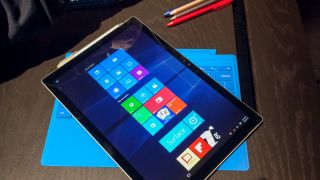
Proof in the product
Whether you’re looking at the iPad Pro, Google Pixel C, Lenovo Miix 700, Dell XPS 12 or HP Spectre x2, all share striking similarities to Microsoft’s Surface tablet. For instance, each has features a detachable screen and magnetic keyboard, a form factor championed first by the Surface tablets.
Some tablets, like the Lenovo Miix 700, hew even closer to the Surface, lifting the same design down to the kickstand.
Meanwhile, with the iPad Pro, it’s apparent Apple built the device to out-do the Surface Pro 4 and every productivity slate from a specs perspective, down to the larger and sharper 12.9-inch screen.
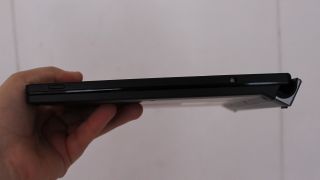
Of course, not every device is a carbon copy. The HP Spectre x2 goes with a kickstand bar to make way for a larger battery while incorporating additional speakers into its keyboard accessory. The Dell XPS 12 was designed as a laptop first, prioritizing the keyboard. Google’s Pixel C represents the greatest departure, incorporating an adjustable hinge into the keyboard rather than relying on a kickstand attached to the back of the screen.
When Microsoft first introduced the Surface as a tablet that could replace your laptop three years ago, it seemed like an absurd claim. But if these multitudes of imitators are any indication, the Windows maker was onto something from the very start, similar to the way the iPhone spawned a whole new generation of smartphones.
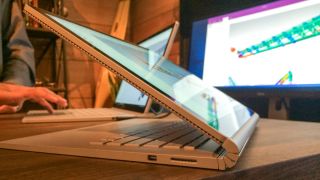
The next generation of laptops
Now the Surface Book could spark a similar revolution in laptops as a shining symbol of innovation. It’s the most unique laptop we’ve seen in years. Look at the aesthetics alone: it includes a hinge that doesn’t fold over, but rather coils into itself while leaving a noticeable gap between the screen and keyboard.
By creating a machine that doesn’t fold completely shut, users can leave the screen at a small angle in draw mode. At the same time, because the machine doesn’t shut fully, Microsoft didn’t need to tuck the keys into a small indentation to prevent them from leaving marks on the screen. From the keyboard deck to the palm rests, the entire interior panel of the laptop is one perfectly smooth and flat surface.
Add in the articulating hinge and its nearly bone white magnesium finish, and the Surface Book looks almost like a concept product. It’s a futuristic design for sure – whether it looks odd or just ahead of the curve will depend on your perspective – however you can’t deny Microsoft has pulled off some new tricks with the basic aesthetics of the Surface Book.
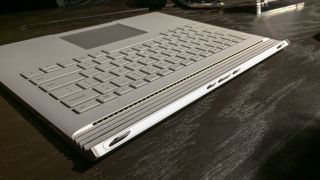
Bleeding-edge hardware
Beyond its fresh and original design, the Surface Book is arguably one of the best specced machine to come out in years. With a 3,000 x 2,000 resolution screen front and center, it’s one of the sharpest looking laptops around while managing to avoid the scaling problems that 4K notebooks run into. It even broaches the line of desktop replacement when fully loaded with a 1TB SSD and 16GB of RAM, plus a desktop GPU.
Aside from the raw performance power of the Surface Book, what makes it all work beautifully together is how the two halves complement each other. Sure you can use the tablet all on its own, but when you slot the screen into the keyboard case it connects to a dedicated Nvidia GPU for an added graphical boost while bumping up its battery life, too.
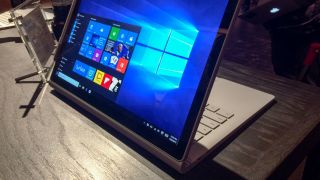
It’s not unlike the technology we’ve already seen in some GPU docking peripherals like the MSI GS30 Shadow with GamingDock and Alienware’s GPU Amplifier solution. Microsoft has improved upon dockable graphics as the Surface Book just needs a short moment to disengage the extra parts, whereas both the Alienware and MSI solutions require the laptop to reboot completely.
When applied to an Ultrabook it might sound like overkill, but it makes a lot of sense if you want a capable notebook that doubles as a thin tablet. The concept is ingenious, really. No 2-in-1 laptop released so far has come with this GPU docking functionality wrapped into it.
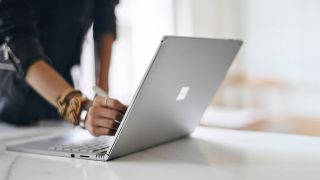
Fire starter
There’s no doubt the Surface Pro represents the cutting edge of Windows 10 laptops, but whether it’s just a flash in the pan or sparks a revolution will depend on its commercial success. There were plenty who thought the Surface tablet family would fail, especially after the whole Windows RT debacle. To its credit, Microsoft stuck with the line and came up with a much-improved formula for the Surface Pro 3.
I can see the Surface Book having some problems of its own between the high-price you’ll pay for adding dedicated graphics and its very large screen size – please let there be a Surface Book Mini. However, I have high hopes Microsoft’s first notebook machine will change the landscape of laptops as we know it, just as the Surface did for tablets.
- How do you think the MacBook Pro will change in response? Leave a comment below!